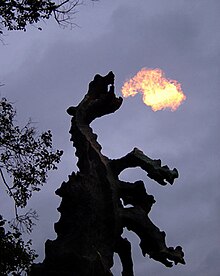Wawel dragon
The Wawel Dragon ( Polish : Smok Wawelski ) is a dragon in Polish folk tales . He is said to have lived in the Smocza Jama (Dragon's Cave) under the Wawel Hill on the banks of the Vistula . Wawel Hill is located in Krakow , which was the capital of Poland until 1596. According to some stories, the dragon is said to have lived there before the city was founded.
history
One of the more famous stories about the Smok Wawelski takes place in Krakow around the time of the reign of Kraks , the legendary founder of the city.
Every day the evil dragon struck a path of destruction through the land, killing the citizens, setting their homes on fire and devouring their cattle. In most versions, the dragon preferred to eat young girls, the only way to appease him was to have a girl perform in front of his cave every month. The king tried everything to stop the beast, but all his brave knights fell victim to the fiery breath of the beast. In the versions that told of the girl sacrifice, all the girls were thrown to the dragon to eat, except for one, the king's daughter Wanda. In desperation, the king offered his daughter's hand to whoever could defeat the dragon. However, no one, coming from near or far, could kill the dragon. One day a young apprentice cobbler named Dratewka volunteered for the job. He filled a dead lamb with sulfur (according to some versions also caustic potash ) and left it in front of the dragon's hoard . The dragon ate it and immediately became very thirsty. He ran down to the Vistula and drank water, but it did not quench his thirst. He drank until he burst from the water in his stomach and died. Dratewka was now allowed to marry the king's daughter and from then on lived happily with her.
today

The Wawel Cathedral and Wawel Castle both stand on Wawel Hill. At the cathedral there is a statue of Smok Wawelski and a plaque commemorating his defeat against Krak , on which it is written that he built the city and his palace over the Dragon's Cave. The cave has become a popular tourist destination today. The street along the bank to the castle is called Smocza Ulica , which means something like "Dragon Street ".
In 1970, a metal sculpture of the Wawel dragon, designed by Bronisław Chromy , was placed in front of the dragon's den ( 50 ° 3 ′ 10.8 ″ N , 19 ° 56 ′ 0.8 ″ E ). It is stylized, the dragon has seven heads, six of which look like legs, and a special feature is that it spits a jet of flame out of its nostrils every five minutes using a natural gas nozzle or after receiving an SMS message.
The archosaur Smok wawelski from the Upper Triassic was named after the Wawel dragon.

